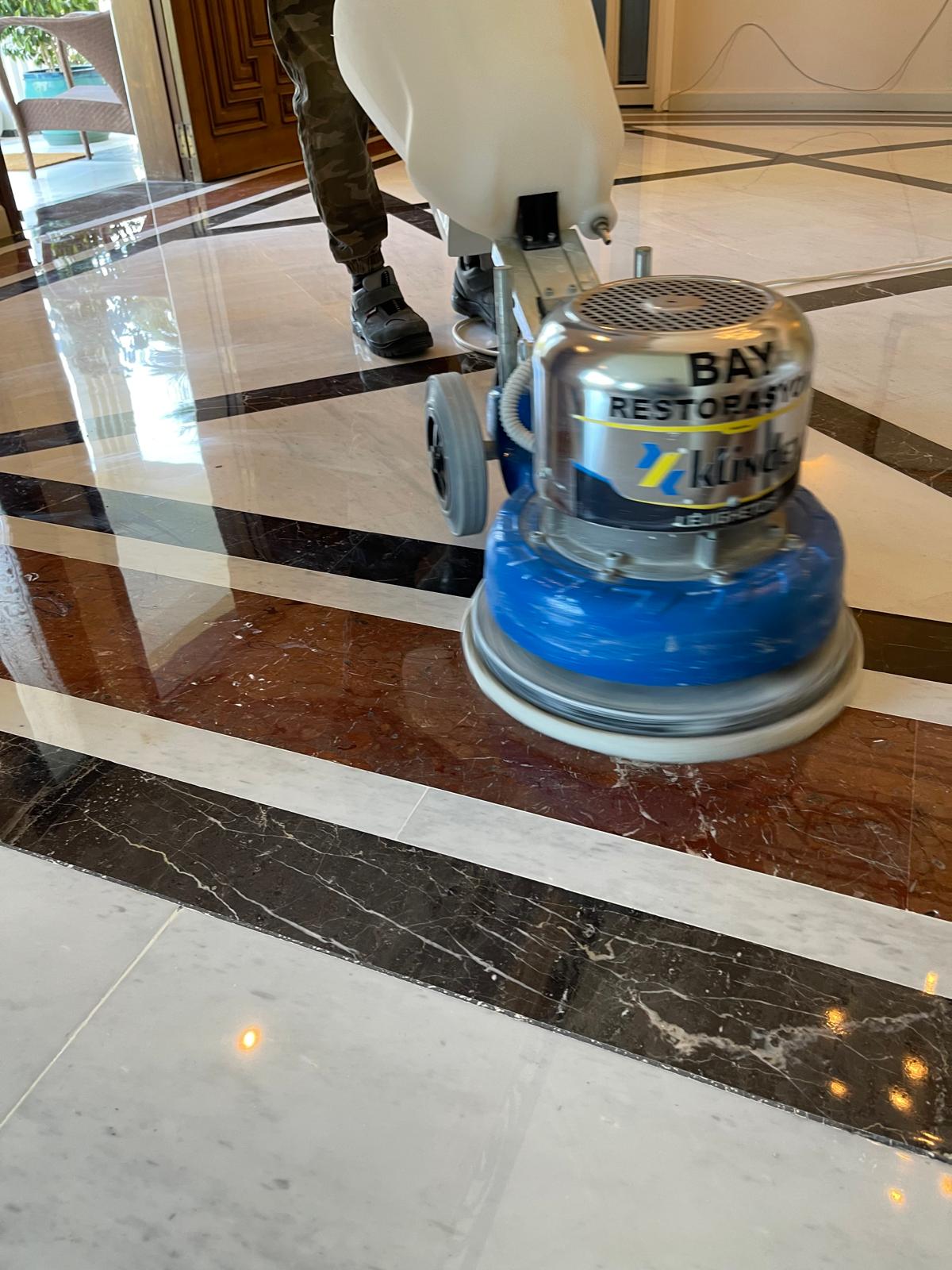What Is Marble Polishing
- Blog
- What Is Marble Polishing
What is Marble Polishing?
Marble Polishing is a surface restoration process used to remove level differences, scratches, and stains on natural stones. In this process, the surface is abraded using special diamonds and resins, bringing it back to its original factory gloss. The surface is treated with a special machine, such as the Klindex brand, in a wet system without generating dust. This process removes the damaged layer, scratches, and stains on the marble surface, restoring it to its original condition.
Marble Sanding
Marble sanding applications vary depending on the area where the marble is used. For large floor areas, Klindex Max machines with 380 power are used, while for smaller areas like homes and offices, Klindex Levigrator machines with 220 power are employed. For counters and staircases, Klindex Baby machines are used, and for narrower spaces, handheld polishing machines are applied. The process is done using water, preventing dust generation, and the surface is cleaned and maintained with water being vacuumed from the floor, resulting in a clean and well-maintained surface.
Marble Surface Polishing and Maintenance
Marble is widely used in residential homes, offices, schools, factories, hotels, hamams, kitchens, bathrooms, and exterior facades. The maintenance of marble varies depending on its type and where it is used. Regular maintenance is essential to preserve its appearance. Over time, marble can be scratched, stained, or accumulate limescale. In these cases, the surface needs to be renewed. If not renewed, the marble's lifespan will be shortened.
Benefits of Marble Polishing
Marble polishing and polishing offer several benefits, in addition to extending the marble's life. These benefits include:
- The surface gains a shiny appearance.
- Stains such as limescale, rust, water stains, and paint residues are removed.
- Scratches, cracks, and chips are fixed, restoring the marble to its original appearance.
- Bacteria, mold, and other harmful microorganisms are prevented, ensuring hygiene.
- The surface’s resistance is increased, providing better durability against chemicals.
- The value of the marble and the space increases.
- Anti-slip features are achieved through processes such as sandblasting, mucarta, and patinato, preventing potential accidents.
- The gaps and pores in the marble joints are filled, providing water resistance.
Marble polishing ensures that marble remains long-lasting, aesthetic, and high-quality with expert services and experienced teams.
What is Marble Polishing?
Marble Polishing is a surface restoration process used to remove level differences, scratches, and stains on natural stones. In this process, the surface is abraded using special diamonds and resins, bringing it back to its original factory gloss. The surface is treated with a special machine, such as the Klindex brand, in a wet system without generating dust. This process removes the damaged layer, scratches, and stains on the marble surface, restoring it to its original condition.
Marble Sanding
Marble sanding applications vary depending on the area where the marble is used. For large floor areas, Klindex Max machines with 380 power are used, while for smaller areas like homes and offices, Klindex Levigrator machines with 220 power are employed. For counters and staircases, Klindex Baby machines are used, and for narrower spaces, handheld polishing machines are applied. The process is done using water, preventing dust generation, and the surface is cleaned and maintained with water being vacuumed from the floor, resulting in a clean and well-maintained surface.
Marble Surface Polishing and Maintenance
Marble is widely used in residential homes, offices, schools, factories, hotels, hamams, kitchens, bathrooms, and exterior facades. The maintenance of marble varies depending on its type and where it is used. Regular maintenance is essential to preserve its appearance. Over time, marble can be scratched, stained, or accumulate limescale. In these cases, the surface needs to be renewed. If not renewed, the marble's lifespan will be shortened.
Benefits of Marble Polishing
Marble polishing and polishing offer several benefits, in addition to extending the marble's life. These benefits include:
- The surface gains a shiny appearance.
- Stains such as limescale, rust, water stains, and paint residues are removed.
- Scratches, cracks, and chips are fixed, restoring the marble to its original appearance.
- Bacteria, mold, and other harmful microorganisms are prevented, ensuring hygiene.
- The surface’s resistance is increased, providing better durability against chemicals.
- The value of the marble and the space increases.
- Anti-slip features are achieved through processes such as sandblasting, mucarta, and patinato, preventing potential accidents.
- The gaps and pores in the marble joints are filled, providing water resistance.
Marble polishing ensures that marble remains long-lasting, aesthetic, and high-quality with expert services and experienced teams.
Hızlı Menü
İletişim
- Eğitim Mah , Ziya Gökalp Sokak No: 100/A , 35330 Balçova İZMİR
- [email protected]
- +90(538) 516 01 01
- 0538 516 01 01
Çalışma Saatleri
- Pazartesi-Cuma: 08:00 - 19:00
- Cumartesi: 08:00 - 16:00
- Pazar: 10:00 - 16:00




